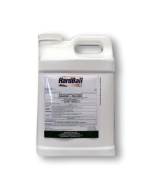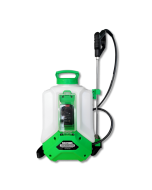Gain access to personalized product screening, the best pricing, rewards, and more!
Hardball Herbicide
Hardball Herbicide is a low-odor, selective post-emergent herbicide with 2,4-D amine that delivers effective broadleaf weed control in turf, pastures, non-crop sites, and other sensitive areas.
01/11/26
Hardball Herbicide, manufactured by Helena Chemicals, is a powerful, new-generation 2,4-D acid herbicide designed for selective, post-emergent control of tough broadleaf weeds and brush in turf, golf courses, aquatic areas, and more.
The power of this herbicide concentrate relies on 2,4-D, which causes uncontrolled growth in noxious plants and leads to stem curl-over, leaf withering, and eventual weed death within a couple of days. One of HardBall Herbicide's key advantages is its ability to provide excellent weed control even in cooler weather, extending treatment windows in spring and fall.
Hardball Herbicide performs well at lower rates than conventional 2,4-D products, offering cost savings and efficiency. Its low-odor, low-volatility, cool-weather performance, and built-in surfactant system make it a standout in areas where precision, discretion, and efficacy matter most.
Tools Needed
A handheld pump sprayer, backpack sprayer, helicopter, fixed-winged aircraft, or spray rig will be needed.
Use power sprayers operated with a boom or spray gun mounted on a boat, tractor, or truck for aquatic treatments.
How to Use
- Step 1: Determine how much Hardball Herbicide to use by measuring the square footage of the treatment area. Find the square footage by measuring the treatment area's length and width in feet, then multiplying them together (length X width = square footage). For acreage, take the square footage and divide it by one acre (square footage / 43,560 sq. ft. = acres). Depending on the cool-seasoned turf, apply 0.56 to 1.28 oz. of Hardball Herbicide per 1 gallon of water per 1,000 sq. ft. For warm-seasoned turf, the rate will vary between 0.75 to 1.28 oz. of product per 1 gallon of water per 1,000 sq. ft. depending on the turf type. Refer to the product label for specific application rates and restrictions.
- Step 2: Fill the spray tank halfway with clean water. Add HardBall at the recommended rate. Continue filling with the remaining half of the water and agitate the solution thoroughly.
- Step 3: Spray the top and bottom of weed leaves until wet, but not to the point of runoff. When spraying shoreline weeds, allow no more than 2-foot over-spray onto the water with an average of less than 1-foot over-spray to prevent the introduction of greater than negligible amounts of the chemical into the water. Do not water the turfgrass for 24 hours after application.
Where to Use
Hardball Herbicide can be used in cool season and warm season turfgrass established for commercial sod production. It may also be used for forest management, forest roadsides, established conifers (including Christmas trees), roadsides, medians, highway, railroad, utility and pipeline rights-of-way, vacant lots, around utility installations, transformers, pump houses, and buildings, storage areas, fences, guardrails, lumber yards, industrial sites, airports, tank farms, farmsteads, and non-crop areas.
Aquatic sites such as lakes, ponds, reservoirs, marshes, bayous, drainage ditches, canals, and rivers and streams that are quiescent or slow-moving can be treated.
When to Use
Best results are obtained when the product is applied to young succulent weeds and brush that are actively growing.
Do not apply immediately before rainfall or irrigation.
Safety Information
Hardball Herbicide is safe for people and pets when applied according to the product label instructions. Always wear the proper personal protective equipment (PPE) when mixing and applying this product.
Keep people and pets out of the treated area until 48 hours have passed after application.
Special Considerations
This product may cause injury to desirable plants by contacting foliage, stems, or roots.
For selective postemergent weed control, do not add oil, surfactant, fertilizer, or other additives.
| Restricted Use | No |
|---|---|
| Shipping Restrictions | AK, CT, DC, DE, HI, IL, ME, NC, NH, SD, VA, VT, WY |
| Availability | Online |
| Signal Word | DANGER |
| Keith's Pro Tip | "Thick, well-fed grass competes with weeds and reduces the chance of reinfestation." |
| Time to Kill | Weeds will be eliminated within 2-4 weeks. |
| Chemical Type | Herbicide |
| Formulation | Microemulsion (ME) |
| Application Methods | Broadcast Spray, Spot Treatment |
| Product Drawbacks | Plants contacted may be killed or suffer significant injury resulting in grade or yield losses. |
| Active Ingredient | 2,4-Dichlorophenoxyacetic Acid 19.6% |
| Application Equipment | Aerial Application Equipment, Backpack Sprayer, Pump Sprayer, Spray Rig |
| Mix Rate | Depending on the cool-seasoned turf, apply 0.56 to 1.28 oz. of Hardball Herbicide per 1 gallon of water per 1,000 sq. ft. For warm-seasoned turf, the rate will vary between 0.75 to 1.28 oz. of product per 1 gallon of water per 1,000 sq. ft. depending on the turf type. |
| Use Sites | Outdoors |
| Yield | 1 gallon of Hardball Herbicide will cover up to 2 acres. |
| EPA Registration No. | 5905-549 |
| Shelf Life | Hardball Herbicide will last up to 3 years when stored in a cool, dry location. Do not store below temperature of 0ºF. If frozen, warm to 40ºF and re-dissolve before using by rolling or shaking container. |
| Comparable Products | Trimec Southern Broadleaf Herbicide |
| Children or pets? | Yes |
| Property Characteristics | None |
| Availability | Online |
| Restricted Use | No |
| Brand | HELENA CHEMICALS |
| Keith's Pro Tips | "Thick, well-fed grass competes with weeds and reduces the chance of reinfestation." |
| Product Drawbacks | Plants contacted may be killed or suffer significant injury resulting in grade or yield losses. |
| Target Pests | Alder, Alfalfa, Alligatorweed, American Lotus, Annual Morningglory, Annual Smartweed, Annual Sowthistle, Aquatic Weeds, Arrowhead, Artichoke, Austrian Fieldcress, Beggarticks, Bidens, Big Sagebrush, Bitter Sneezeweed, Bitter Winter Cress, Blackeyedsusan, Blessed Thistle, Blue Lettuce, Blue Thistle, Bluegrass, Boxelder, Buckbrush, Buckhorn Plantain, Bull Thistle, Bullnettle, Bulrush, Bur Ragweed, Burhead, Canyon Live Oak, Carolina Geranium, Carpetweed, Catnip, Ceanothus, Chamise, Chickweed, Chicory, Coastal Sage, Coffeeweed, Common Broomweed, Common Burdock, Common Cinquefoil, Common Cocklebur, Common Lambsquarters, Common Morningglory, Common Purslane, Common Ragweed, Common Salsify, Corn Gromwell, Cornflower, Coyotebrush, Creeping Jenny, Curly Indigo, Cutleaf Eveningprimrose, Dandelion, Devil'S Claw, Dock, Dogbane, Dogfennel, Douglas-Fir, Duckweed, Dwarf Mallow, Elderberry, European Bindweed, Fanweed, Figwort, Four-O'Clock, Giant Ragweed, Goatsbeard, Goldenrod, Grand Fir, Ground Ivy, Hairy Galinsoga, Hawkweed, Healall, Hedge Bindweed, Hemlock, Hemp, Henbit, Hoary Cress, Honeysuckle, Horsetail, Indian Mallow, Indigo, Ironweed, Ivyleaf Morningglory, Jimsonweed, Klamath Weed, Knotweed, Ladysthumb, Little Mallow, Madrone, Manyflowered Aster, Manzanita, Marestail, Marshelder, Mayweed, Mexicanweed, Milkvetch, Mousetail, Musk Thistle, Mustard, Nettle, No Pest, Nutgrass, Parrotfeather, Parsnip, Pennsylvania Smartweed, Pennycress, Pennywort, Peppergrass, Pepperweed, Perennial Ryegrass, Pigweed, Plantain, Poison Ivy, Pokeweed, Poorjoe, Povertyweed, Prickly Lettuce, Puncturevine, Quickweed, Rabbitbrush, Radish, Red Clover, Redstem, Rough Cinquefoil, Rough Fleabane, Russian Thistle, Saltcedar, Sand Sagebrush, Sand Shinnery Oak, Shepherdspurse, Sicklepod, Smallflower Buttercup, Smallflowered Bittercress, Spanishneedles, Spatterdock, Speedwell, Spiny Sowthistle, St. Johnswort, Stinging Nettle, Stinkweed, Sumac, Sunflower, Sweetclover, Tall Fescue, Tanoak, Tansy Ragwort, Tarweed, Texas Blueweed, Texas Croton, Toadflax, Tumbleweed, Velvetleaf, Venice Mallow, Vervain, Vetch, Virginia Copperleaf, Virginia Creeper, Waterhyacinth, Waterlily, Watermilfoil, Waterprimrose, Western Ironweed, Western Salsify, Wild Carrot, Wild Garlic, Wild Lettuce, Wild Mustard, Wild Onion, Wild Parsnip, Wild Radish, Wild Rape, Wild Sweet Potato, Willow, Witchweed, Woolly Croton, Wooly Morningglory, Wormwood, Yellow Goatsbeard, Yellow Rocket, and Yellow Starthistle. |
| Application Equipment | Aerial Application Equipment, Backpack Sprayer, Pump Sprayer, Spray Rig |
| Application Methods | Broadcast Spray, Spot Treatment |
| Active Ingredient | 2,4-Dichlorophenoxyacetic Acid 19.6% |
| Product Type | Herbicide |
| Formulation | Microemulsion (ME) |
| Application Rate | Depending on the cool-seasoned turf, apply 0.56 to 1.28 oz. of Hardball Herbicide per 1 gallon of water per 1,000 sq. ft. For warm-seasoned turf, the rate will vary between 0.75 to 1.28 oz. of product per 1 gallon of water per 1,000 sq. ft. depending on the turf type. |
| Shelf Life | Hardball Herbicide will last up to 3 years when stored in a cool, dry location. Do not store below temperature of 0ºF. If frozen, warm to 40ºF and re-dissolve before using by rolling or shaking container. |
| Yield | 1 gallon of Hardball Herbicide will cover up to 2 acres. |
| Use Sites | Outdoors |
| Time to Kill | Weeds will be eliminated within 2-4 weeks. |
| Comparable Products | Trimec Southern Broadleaf Herbicide |
| Use Caution With | Bentgrass, St Augustine |
| EPA Registration # | 5905-549 |
*Price does not include freight. We guarantee our rate plus shipping will be less than anyone else's price.














